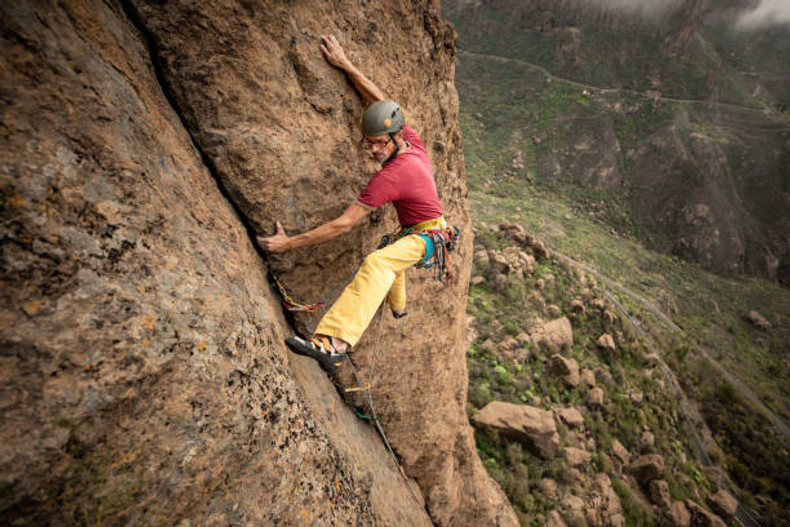Great climbers make it to the top by using moves designed to help solve problems. Becoming a better climber happens by perfecting techniques. The best way to do that is by practicing the principles of technique and balance. After that you can concentrate on tackling individual moves.
REI has laid out some significant climbing and balancing tactics:
Basic Feet Techniques:
Edging- when you step on a hold with the rubber edge of your shoe. You can use the inside edge, where your big toe offers stability on smaller holds, or you can use the outside edge. Your choice depends on the direction you need to move in order to get on or off the hold.
Smearing- happens when you don't have a foothold, so you rely on your shoe's rubber for friction. Smearing is useful in slab climbing; low-angle rock without many defined footholds. The idea is to locate small depressions or protrusions that will provide extra friction. You can also flatten out the angle for slightly better acquisition.
Balancing tactics:
- Keep your feet directly below you.
- Look for footholds in good positions to maintain better balance.
- Foot placements take priority over handholds.
- Once your foot is set, keep it still.
- Keep your heel low to maintain contact with the wall.
- Use your body to maintain balance on routes that demand move and pull in various directions.
- Pull straight down on a hold that’s out to the side
- Press your foot in the opposite direction of the pull to create counter pressure.
- Pull in the opposite direction with your other hand or a hooked foot.
- Lean over hard and use your body weight as a counter balance.
Use less energy and give your muscles a break:
- Straighten your arm to allow your skeleton to take most of the weight, not your muscles.
- Keep one hip against the wall so the weight stays over your feet and lean back with straight arms. A close shoulder also changes the angle of pull on handholds, making them easier to grip.
- Spot holds that allow you take a quick rest without focusing simply on the chalk marks. Find a good rest; allow your pulse to slow down and shake out your arms.
Individual Moves:
Back Step- helps get your hip close to the wall, making it easier to straighten your arms and take a rest. Also helps provide enough extension to reach an elusive hold. Especially useful for saving energy on steep and overhanging routes.
Drop Knee-a more extreme back step. A drop knee gets your hip close to the wall. Especially helpful when you need extra reach on a steep or overhanging wall.
Stemming- pushing against two opposing surfaces using any combination of hands and feet, but the key is to use counter pressure to stay in balance. Since stemming relies on leg muscles it's an extremely efficient way to climb, and allows some needed rests.
Flagging- shifting your weight by using a limb to keep from swinging away from the rock.
Flagging is advantageous when you're using holds on the same side of your body. It shifts all the weight to one side, so that leg can swing out to the other side of your body to maintain balance.
Lay-backing-when you pull and lean off one side of a flake or a crack and push your feet against the other side. When you have good footholds, laybacks are very efficient because your arms are straight and your feet do the hard work.
Mantle- when you push down on a hold and bring feet up to meet hands. Push down on a hold to get your weight above it, then move your foot up to take the place of your hand. Mantles are necessary when you top out, but are also useful mid-climb when you have a big handhold and you need to get your feet high.
Undercling-when you use the underside of a hold. Instead of pulling down on the hold, you're pulling up. Finding a good, high foothold helps creates body tension by pushing with your feet as you pull on the hold. Positioning your feet high keeps the hold around waist level and allows your arms to straighten. A undercling executed properly positions a reach for extra elevation.
Side Pull-a hold that's oriented for a sideways pull. The key to a well-executed side pull is to balance out by shifting your body weight or by applying a counter force. Side pulls can feel awkward because you have to adapt your pull to the orientation of the hold.
Gaston-the inverse of side pull. In a side pull, the hold is oriented so that you pull in, toward yourself. A gaston is also oriented for a sideways force, but instead of pulling in, it requires a push out. This position may feel unstable because all the force comes from your shoulder.
Palming- pushing against the rock with an open palm to maintain balance while repositioning your feet. Palming is useful if no good handholds can be found. Also, when stemming or on slab climbs because it allows counter pressure to be applied to a flat surface.
Good technique is of the utmost importance. If you stay focused on perfecting technique, moves start to click into place and you find yourself easing through courses that may have been difficult in the past.

